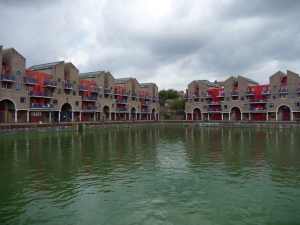 Historic England (HE) has listed 17 bold, playful, brightly coloured post-modern buildings of the late 1970’s to 1990’s across six categories: culture, housing, education, civic, commercial and law, and ranging from Crown Courts in Cornwall to warehouses in Slough and housing schemes in London Docklands.
Historic England (HE) has listed 17 bold, playful, brightly coloured post-modern buildings of the late 1970’s to 1990’s across six categories: culture, housing, education, civic, commercial and law, and ranging from Crown Courts in Cornwall to warehouses in Slough and housing schemes in London Docklands.
Image: Shadwell Basic Development by Christine Matthews, CC BY-SA 2.0, https://commons.wikimedia.org/w/index.php?curid=14193425
Historic England writes:
The listings follow Historic England’s research into this architectural style and recommendations that the Department for Digital, Culture, Media and Sport give these buildings heritage protection.
Post-Modern architecture emerged in the 1970s as a critical reaction to Modernism. In Britain it was closely associated with the economic boom of the 1980s. After a period out of favour, the 2011 exhibition ‘Style and Subversion’ at the V&A marked a revival of interest in Post-Modernism.
The style was an important strand of late 20th century architecture, but Post-Modern buildings can be vulnerable to change and loss which is why the best examples have been selected for listing.
Duncan Wilson, Chief Executive of Historic England, said: ‘Post-Modern architecture brought fun and colour to our streets. Housing schemes were enlivened with bold façades, a school technology building was decorated with columns designed as screws, a business park injected with glamour. These are scarce survivals of a really influential period of British architecture and these buildings deserve the protection that listing gives them.’
Read more and see the complete list
